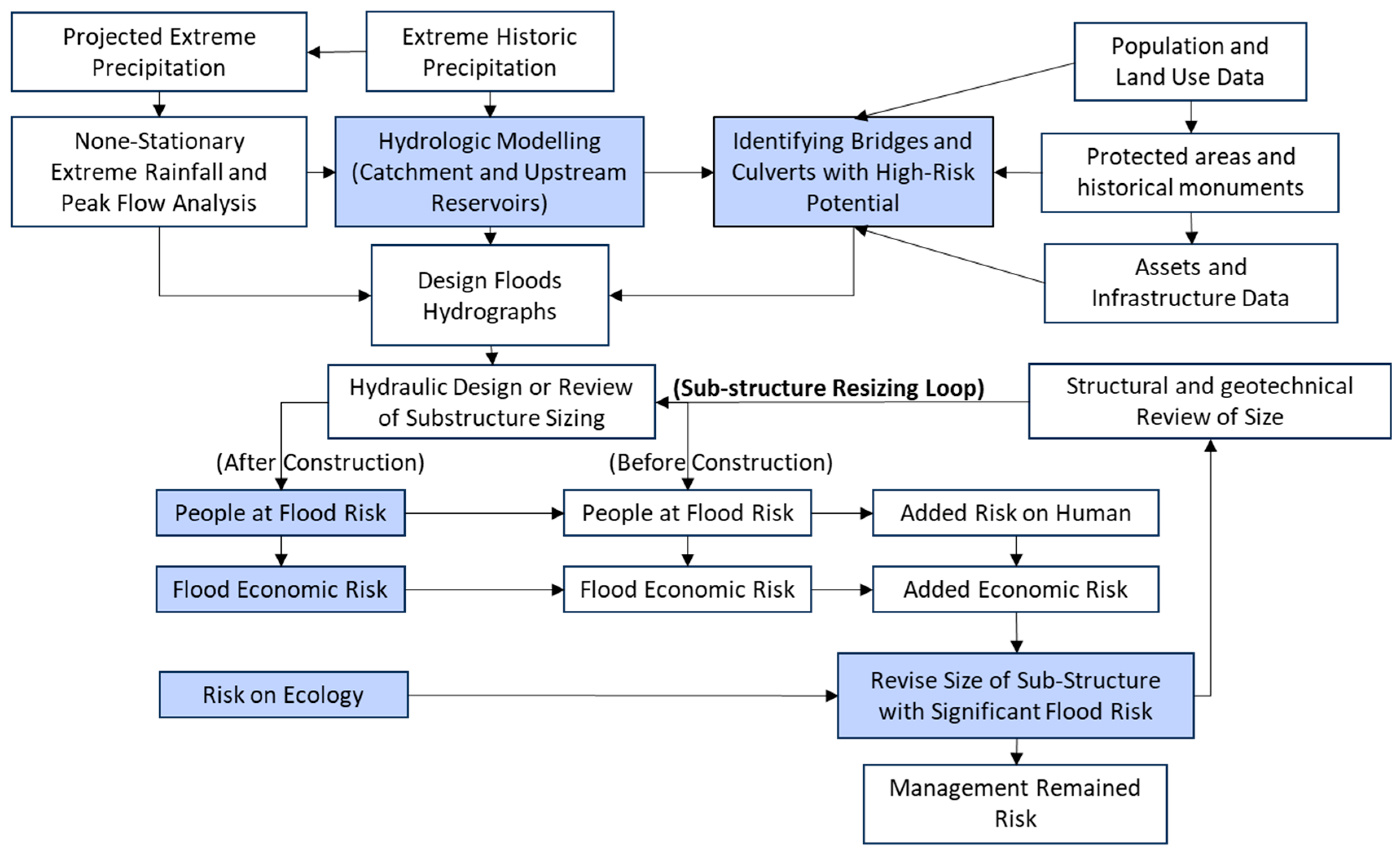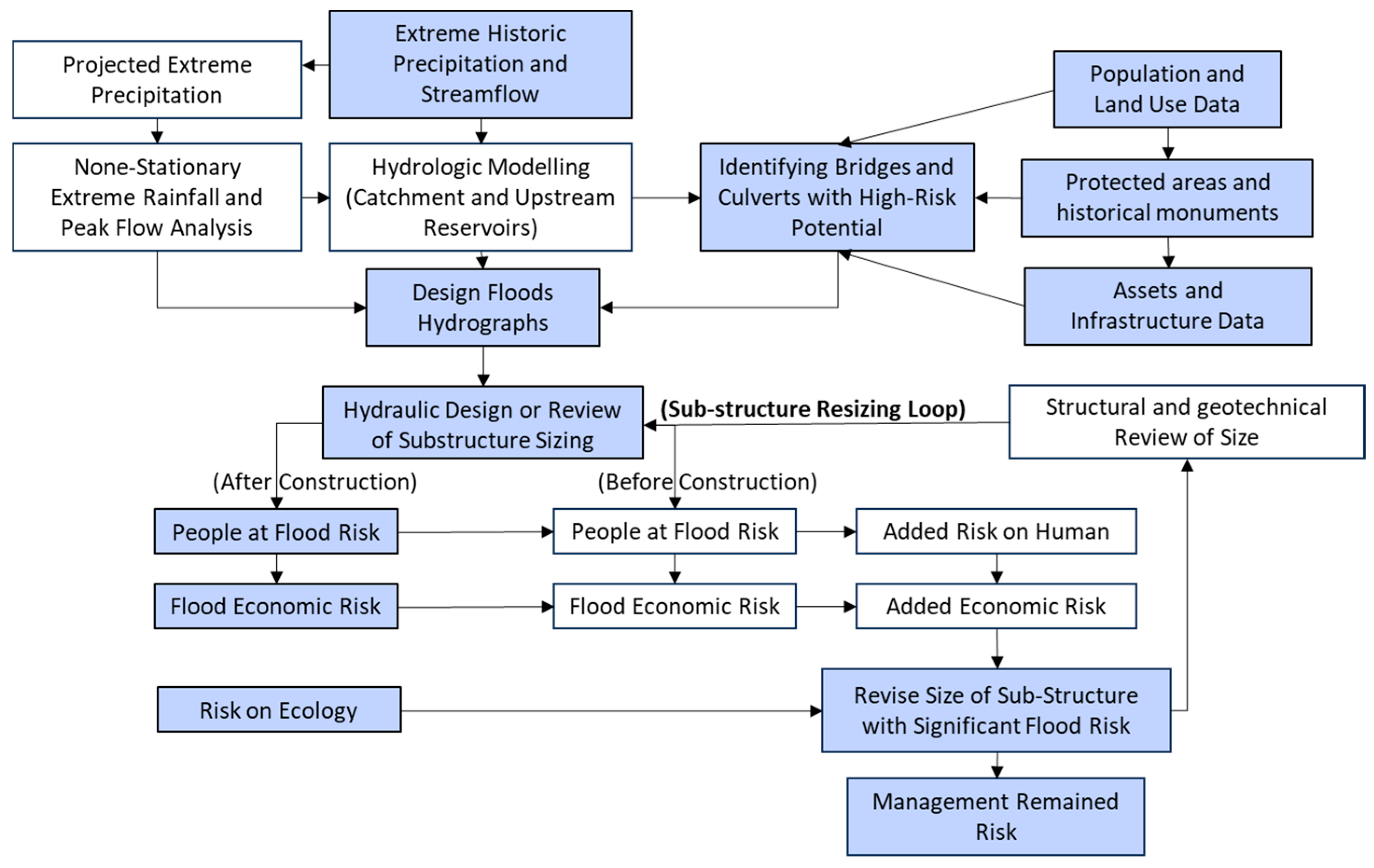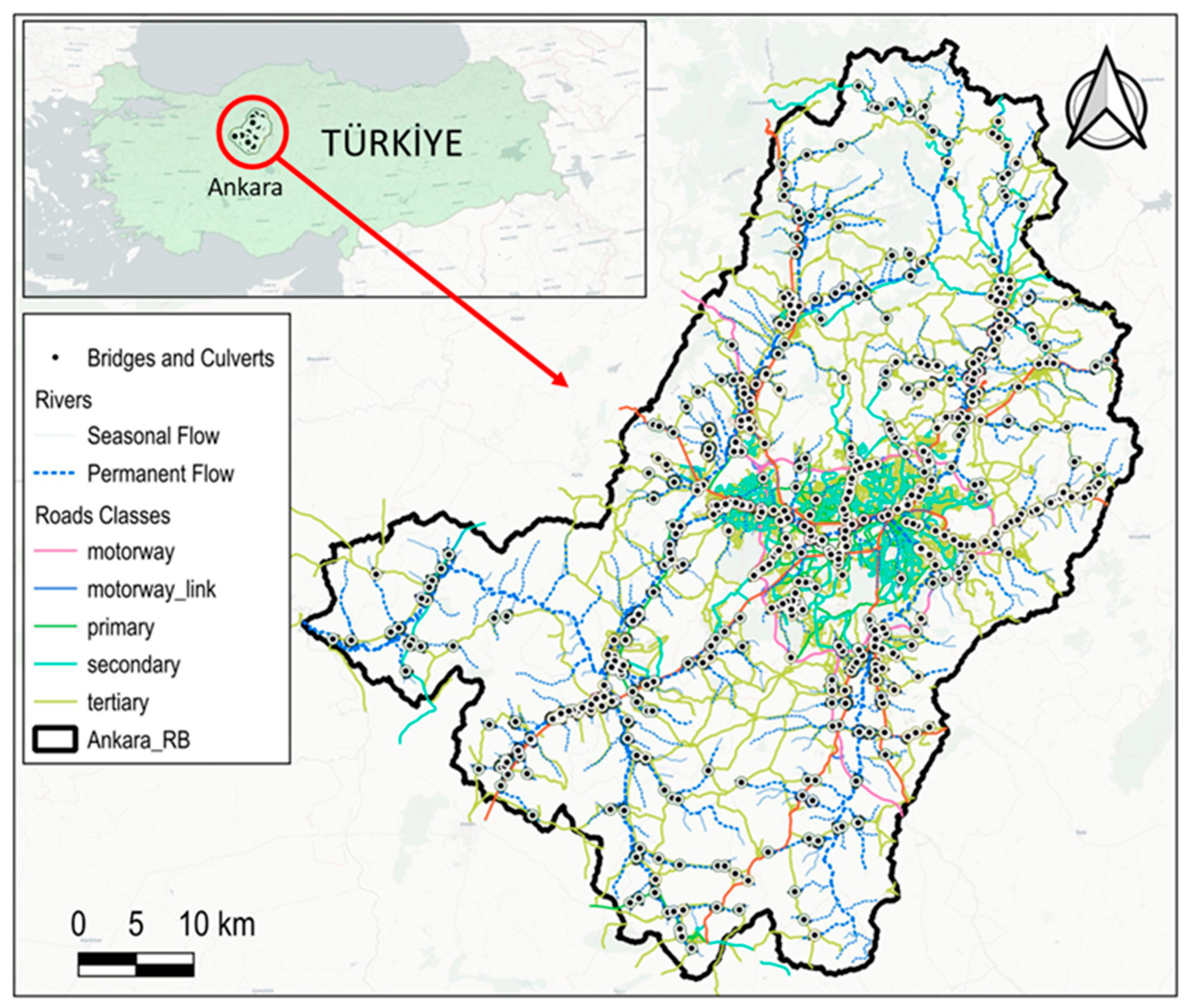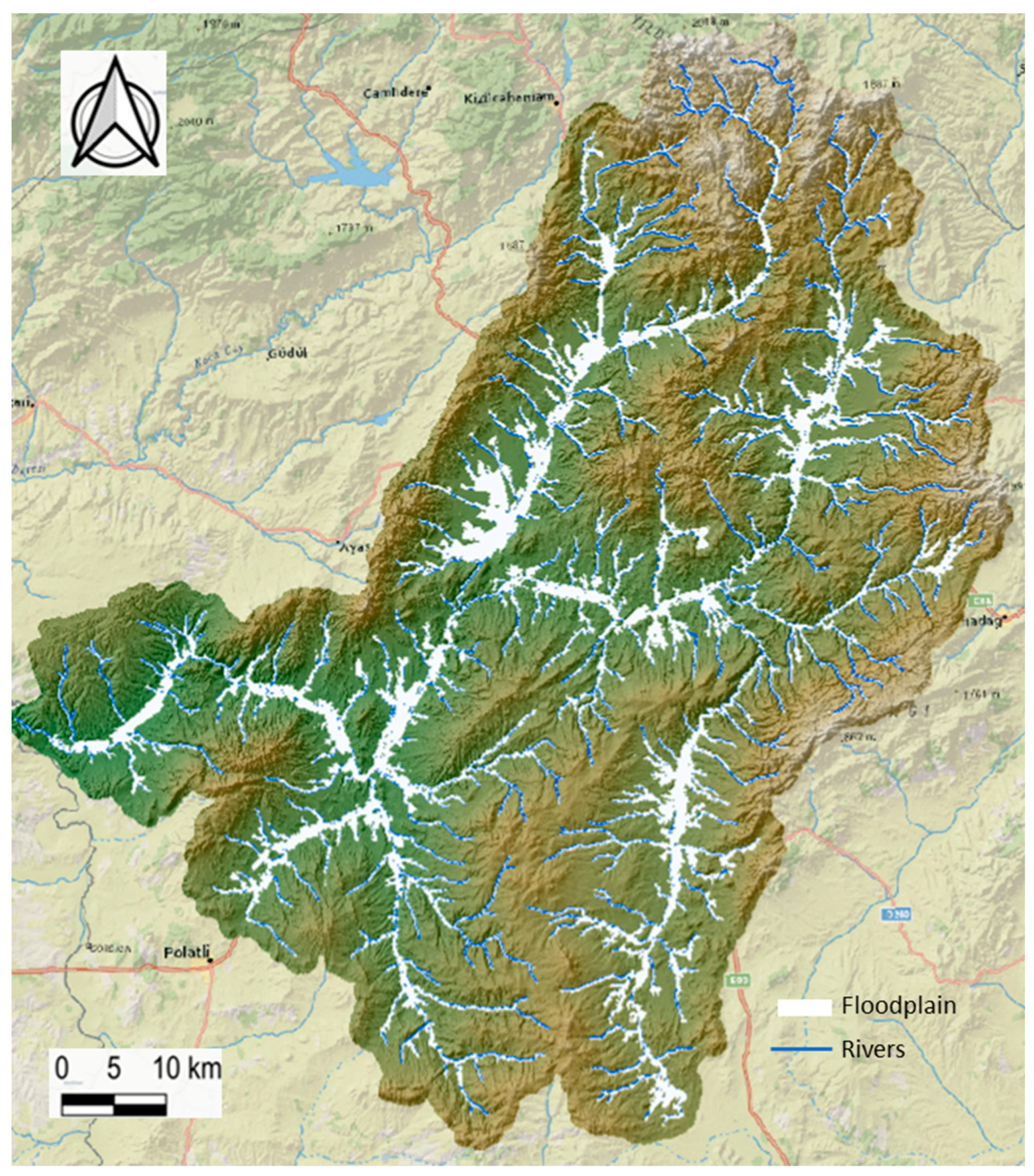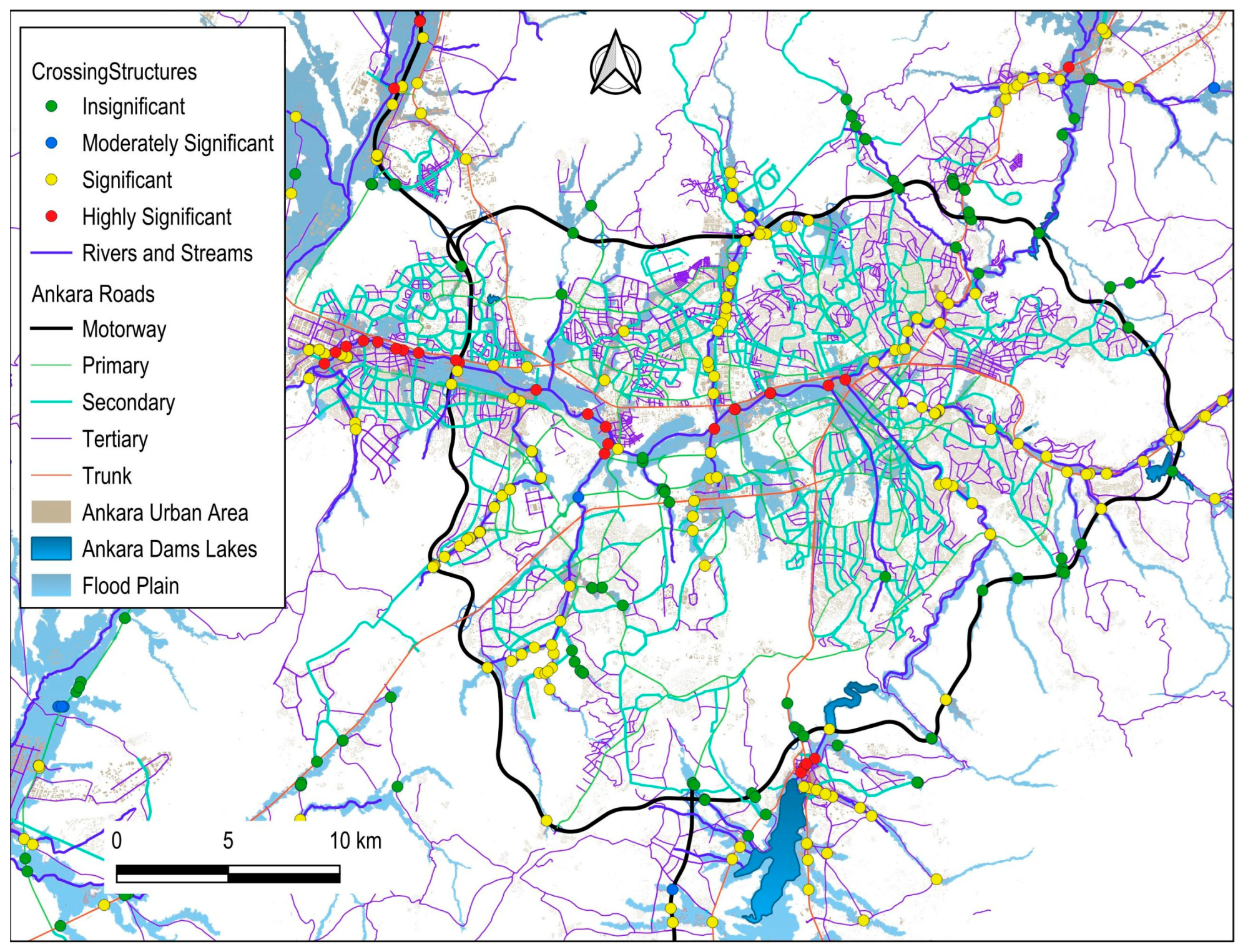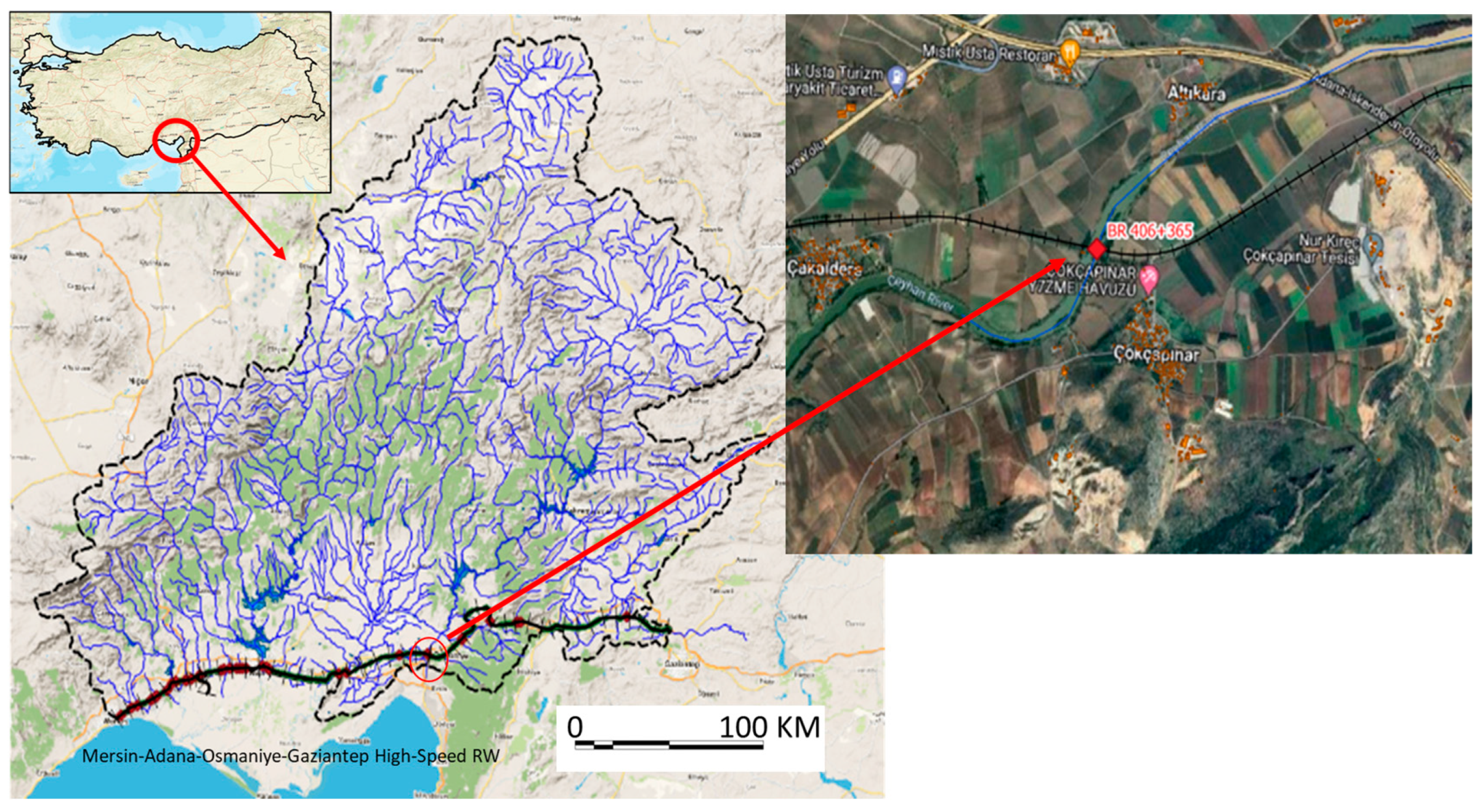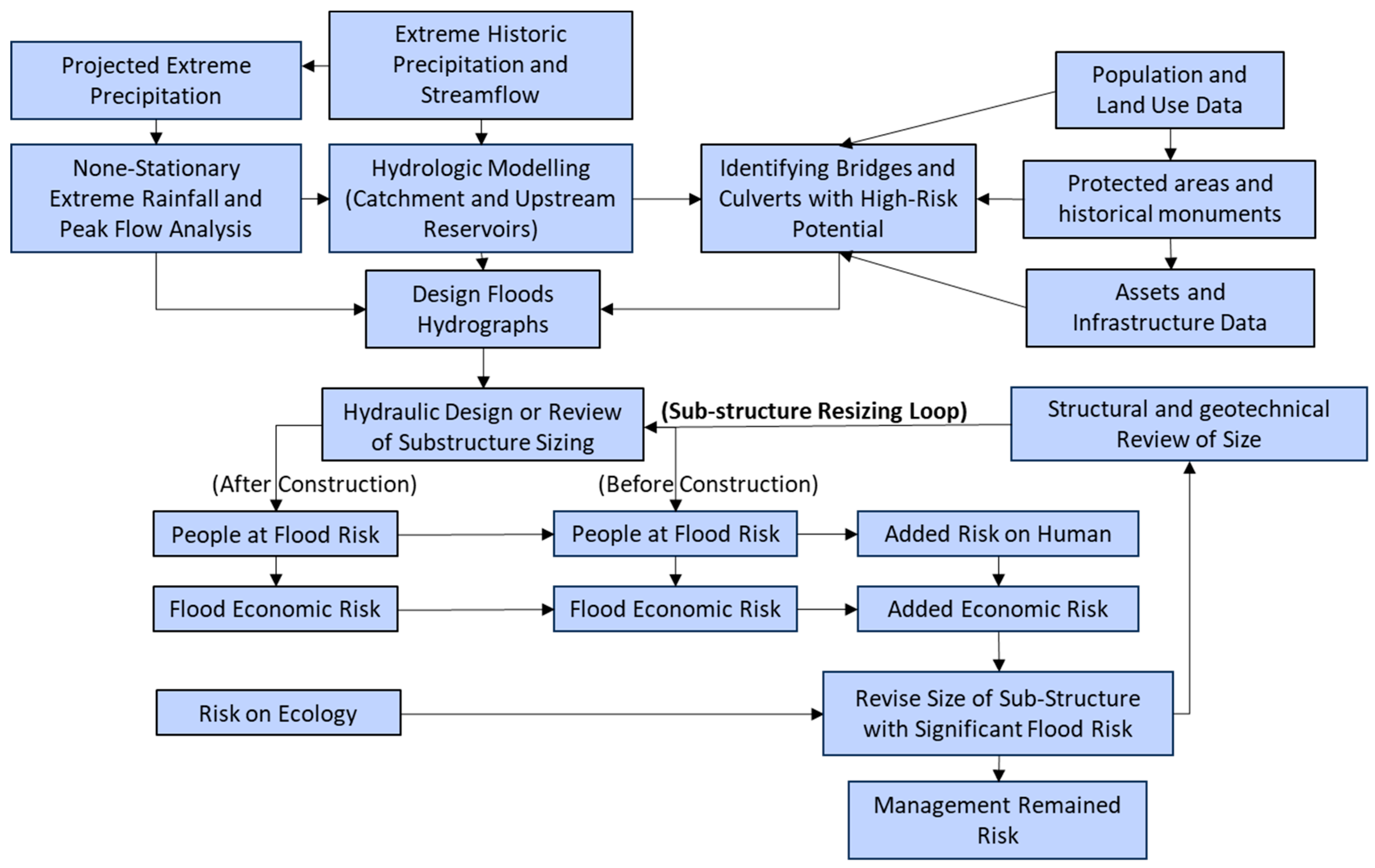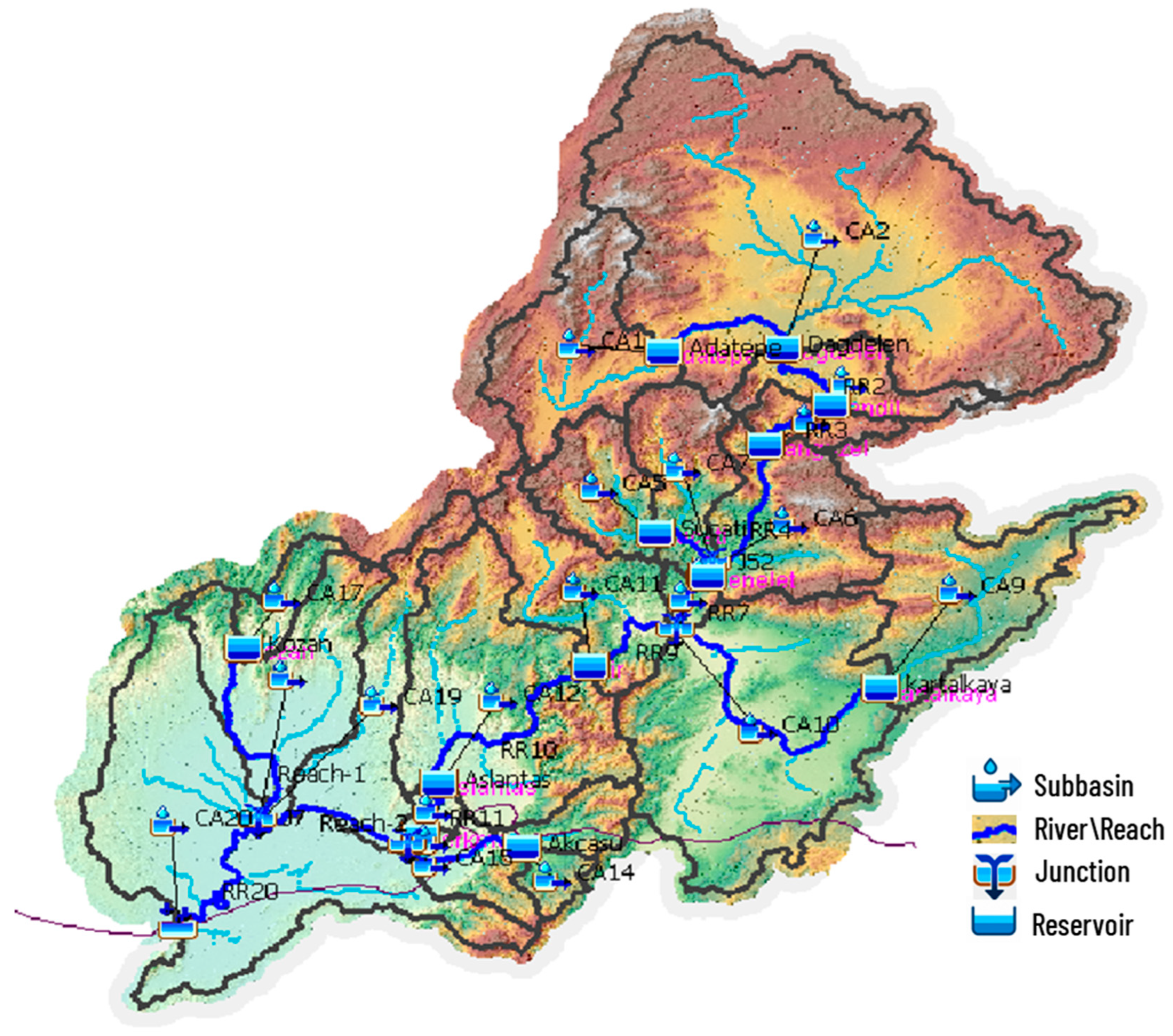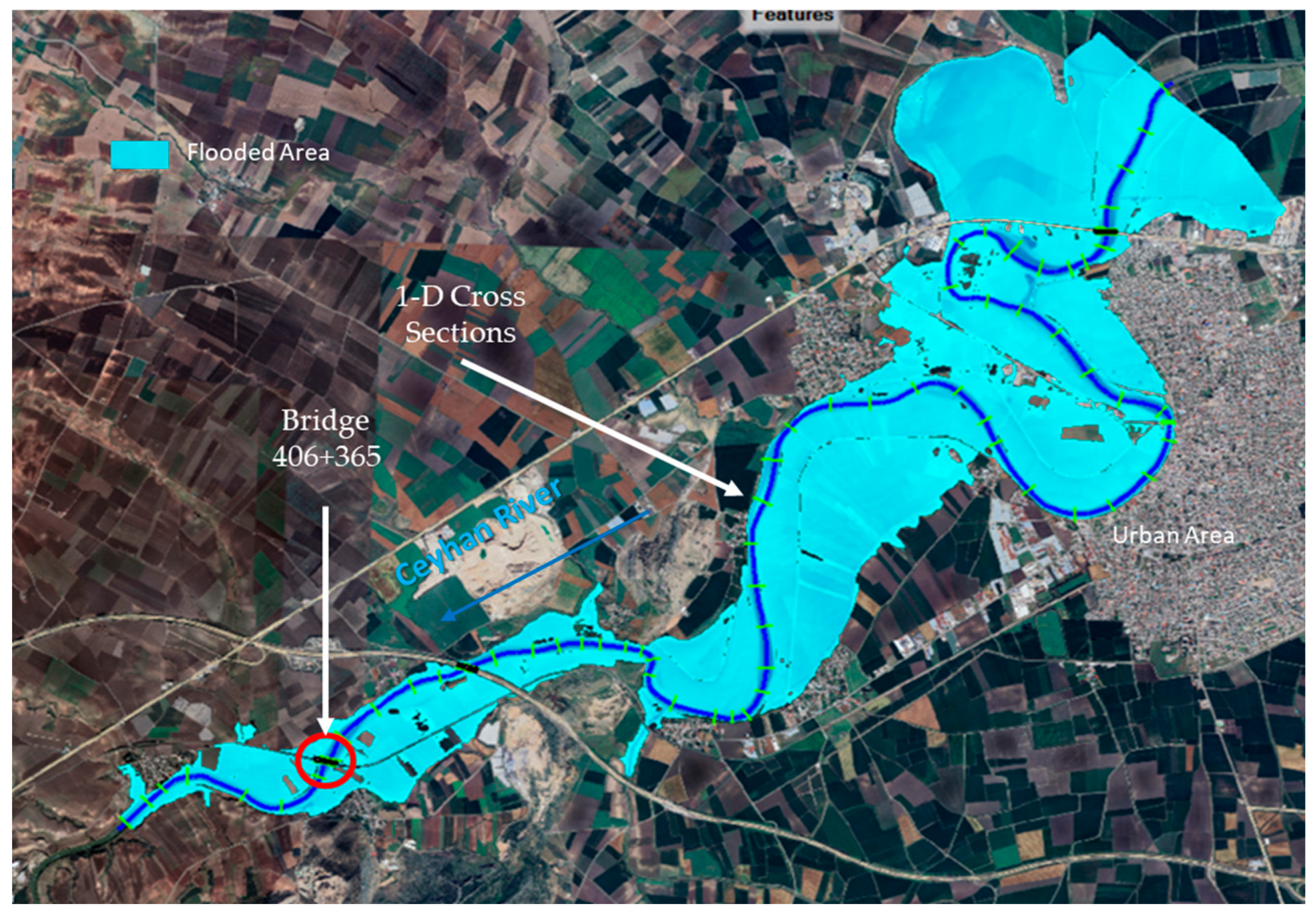1. Introduction
Flooding threatens public safety, disrupts economic activities, damages critical infrastructure, and causes long-term environmental degradation. To mitigate these adverse impacts, it is essential to incorporate climate change considerations into planning and hydrological modeling methodologies. The 2007 COP 13 meeting in Bali, Indonesia, underscored the importance of climate change adaptation and technology transfer, particularly for developing countries. It called for developing climate-resilient strategies and robust risk management approaches that align with broader sustainability and development objectives [
1].
Bridges, culverts, and viaducts are integral components of road and railway infrastructure, ensuring the continuity of transportation networks while facilitating the safe and efficient conveyance of floodwaters. Historically, the design of these structures has been driven by hydraulic, structural, and economic considerations, with the primary goal of ensuring serviceability and safety [
2]. However, recent developments have revealed significant limitations in traditional design methodologies. The combined impacts of climate change and urbanization have significantly altered the hydrological regimes of many river basins, leading to increased flood frequency, magnitude, and variability [
3,
4,
5]. Structures originally designed using historical hydrological data and static design assumptions are now vulnerable to structural instability, accelerated degradation, and higher maintenance costs. Furthermore, urbanization has intensified runoff and sediment transport, further burdening critical infrastructure and shortening its operational lifespan [
6]. Retrofitting existing structures to adapt to these evolving challenges is financially burdensome and technically complex. The lack of climate adaptation considerations in current design practices further exacerbates the vulnerability of transportation networks to future flood hazards [
7]. Given the increasing frequency and intensity of climate-related flood events, there is a pressing need to reassess hydraulic design practices within the broader context of flood risk management. Conventional design approaches typically focus on optimizing hydraulic performance at specific crossing points but often neglect the broader flood dynamics across entire river basins and the cumulative effects on upstream and downstream areas [
8,
9].
Jia et al. (2018) [
10] developed a multi-criteria evaluation framework to compare accelerated bridge construction (ABC) with conventional bridge construction methods. The framework estimates construction, agency, and user costs, including mobility, reliability, safety, and climate change impacts. A novel cost comparison model was introduced, and two decision-making tools—return on investment (ROI) and TOPSIS—were applied. Results demonstrated that TOPSIS provides more effective decision support, making it valuable for urban planning and sustainable infrastructure development.
Ebrahimian et al. (2021) [
11] complemented this approach by presenting a simplified methodology for prioritizing bridges and culverts for ABC projects based on flood vulnerability and climate risks. Their MCDA framework, implemented in a GIS environment, incorporates critical factors such as extreme weather events, storm surges, urbanization, and sea level rise (SLR). The model explicitly addresses bridge failure due to scour, which accounts for 52% of failures in the U.S. A case study in Miami-Dade County, Florida, illustrated the framework’s practical application for guiding state DOTs in prioritizing upgrades and replacements.
Expanding on regional risk assessment, Duran et al. (2025) [
12] analyzed the flood susceptibility of over 24,000 bridges in Iowa using AHP and fuzzy AHP techniques. The study integrated bridge inventory data with historical flood records and evaluated risks for 50-, 100-, and 500-year return periods, based on variables such as bridge age, structural condition, traffic volume, and detour length. Impact indices were calculated at various spatial scales and visualized through kernel-based heatmaps, incorporating population data to reflect potential societal consequences. The results revealed high-risk areas and offered valuable guidance for resilience planning.
These studies underscore the growing need for integrated flood risk assessment and multi-criteria decision-making tools to support resilient, cost-effective, and climate-adaptive infrastructure design and construction. However, despite these advancements, a critical gap remains in developing a unified, scalable methodology that accounts for climate-driven hydrological variability, infrastructure vulnerability, and societal impacts across different spatial and temporal scales. The present study aims to address this gap by introducing a novel decision-support framework that utilizes multi-objective optimization and scenario-based analysis to generate adaptive, resilient, cost-effective design solutions responsive to future climatic and hydrological uncertainties. By incorporating climate change, social, environmental, and economic factors alongside traditional hydraulic performance criteria, the proposed methodology aims to enhance infrastructure resilience and sustainability. The proposed methodology emphasizes basin-wide flood dynamics, infrastructure interdependencies, and adaptation to future climate scenarios.
The paper first reviews the limitations of the existing design approach and then proposes a comprehensive methodology and framework to address these gaps. Finally, two case studies from Türkiye illustrate the proposed framework’s practical application.
2. Methods and Materials
2.1. Challenges in Traditional Hydraulic Design and Construction
The classification of crossing structures, including bridges, culverts, and viaducts, over streams and rivers varies across countries, influenced by design criteria, structural significance, traffic volume, and geographical location. Different regions employ distinct terminologies to categorize these structures, often differentiating between minor and major types or distinguishing between urban and rural settings [
13]. In the flood design category, a synthesized summary of design criteria derived from multiple United States and European Union standards for bridges and culverts is provided in
Table 1. Design floods for bridges and culverts in the European Union (EU) are determined according to national standards, EU directives, and guidance documents from engineering bodies like PIARC, CEN, and ISO. Unlike the United States, where FHWA [
14,
15] and AASHTO [
16] provide centralized guidance, Europe uses a more decentralized approach with harmonized principles under the EU Water Framework Directive (WFD) and Eurocodes.
In China, bridge and culvert designs follow national standards such as JTG D60-2015 [
17] for highway structures and TB10002.1-2005 [
18] for railway infrastructure. While explicit return periods may vary across applications, a general practice aligns with international norms—100-year return periods for bridges and 50 years for culverts. Hydrological analysis is grounded in historical flood data, catchment modeling, and regional flood estimation practices. Although climate change adaptation is not yet formally mandated, it is gradually being considered.
Similarly, in India, the design flood return period for bridges is typically 100 years, while culverts are designed for return periods ranging from 25 to 50 years, as specified in IRC: SP:13-2022 [
19]. These values are supplemented by guidance in IRC: SP:42-2014 [
20], which recommends 25 years for urban drainage and 10 years for rural drainage systems. The Indian approach emphasizes regional empirical formulas and IDF (intensity–duration–frequency) data from the Indian Meteorological Department, with increasing attention to climate resilience.
In Türkiye, the classification of crossing structures follows guidelines established by the General Directorate of Highways (KGM) [
21], in conjunction with the standards set by the Turkish Standards Institute (TSE) [
22] and the State Hydraulic Works (DSI) [
23]. Specifically, crossings spanning less than 12 m are classified as culverts, whereas those exceeding 12 m are categorized as bridges. The design criteria for these crossing structures in Türkiye are outlined in Articles 11 and 12 of the Regulation Governing Engineering Structures such as Bridges and Culverts Built on Rivers, alongside additional flood and sediment control regulations. These provisions are established in Article 55 of the National Hydraulic Works Law (Law No. 6200) [
24], dated 17 December 1953, and Article 121 of the Presidential Decree on the Organization of Ministries and Related Institutions, dated 15 July 2018 [
25]. The most recent version of this regulation was published on 3 May 2019, with amendments issued on 2 June 2024, as detailed in
Table 2.
The table outlines typical standards for determining the high water level (HWL) and the required freeboard to design bridge and culvert sub-structures in urban and rural areas. It specifies design flood standards based on return periods, which reflect the statistical likelihood of a flood event occurring within a given year (e.g., Q100 indicates a flood with a 1% annual chance of occurrence). The parameters V (average velocity in m/s) and h (average water depth in meters) are used to estimate flood impacts, considering the worst-case hydraulic conditions for different land use scenarios. Urban areas require more stringent design standards due to higher flood risk and greater infrastructure density. In contrast, rural areas allow for slightly more relaxed criteria, reflecting the lower flood risk exposure, while ensuring structural safety and resilience during significant flood events.While existing standards provide valuable guidance on the hydrological and hydraulic risks associated with bridges and culverts at a local scale, they often fall short of addressing the broader impacts of flooding, which is inherently a regional phenomenon with significant upstream and downstream consequences. Moreover, the increasing frequency and severity of floods, driven by climate change and urbanization, must be systematically incorporated into design criteria.
Incorporating climate adaptation strategies into design practices and flood risk management is essential to effectively addressing these evolving challenges. This will enhance bridges’ resilience and ensure they can withstand future hydraulic and hydrological uncertainties.
2.2. Designing Cost-Effective and Resilient Bridges and Culverts
In infrastructure design, the adaptive design of highway and railway substructures necessitates an integrated approach that combines hydrology, hydraulics, climate modeling, geotechnical analysis, risk assessment, and optimization techniques. Advanced technologies, such as fuzzy logic and multi-criteria analysis [
10,
11,
26,
27,
28,
29], play a pivotal role in enhancing infrastructure resilience to extreme flood events. These tools enable the analysis of complex flood scenarios and the development of adaptive, flexible designs to accommodate future climate uncertainties. Applying these methods ensures that infrastructure can effectively withstand the increasing frequency and severity of flood events, ultimately improving long-term sustainability and reducing flood risk.
To mitigate these risks, multi-objective optimization techniques can be applied to the hydraulic design of bridges and culverts. These techniques enable engineers to balance the trade-offs between cost, flood risk, and infrastructure efficiency, ensuring that designs are affordable and resilient against future flood events. By simulating various flood scenarios, including those influenced by climate change, these approaches help ensure that bridge and culvert infrastructure remains robust, even in unpredictable environments. Scenario-based modeling, which accounts for varying levels of flood intensity and climate change projections, is crucial in creating flood-resistant bridges and culverts [
30].
Adaptive design strategies are also key to integrating flood risk management with bridge and culvert design. These strategies enable infrastructure to adapt to environmental conditions, such as altered rainfall patterns or rising sea levels. Instead of relying solely on static designs based on historical data, adaptive designs create flexible systems that can evolve as climate conditions change over time [
31].
Probabilistic flood analysis is another promising method to enhance the flood resilience of bridges and culverts. This approach incorporates uncertainty into flood predictions, offering a more comprehensive understanding of potential flood risks by considering a range of possible outcomes, rather than relying on deterministic models that focus on a single scenario [
32]. By accounting for this uncertainty, engineers can design bridges and culverts that are more adaptable to unforeseen future conditions, enhancing long-term resilience. Additionally, nature-based solutions such as wetlands, floodplains, and green infrastructure, are increasingly integrated into flood management strategies for bridges and culverts. These solutions help reduce flood peaks, improve water retention, and protect the foundations of bridges and culverts from erosion [
33]. Innovations such as self-healing concrete, which automatically repairs cracks caused by water infiltration, also help reduce maintenance needs and extend the durability of bridge and culvert infrastructure [
34].
Technological advancements in monitoring and data collection also contribute to the resilience of bridges and culverts. Real-time scour monitoring using acoustic and fiber-optic sensors can detect early signs of scour around bridge piers, preventing potential structural failures [
35]. Remote sensing technologies, such as drones and satellite imagery, have revolutionized flood monitoring and sediment transport analysis. These tools provide real-time data that aid in maintaining bridges and culverts, allowing them to adapt to changing flood conditions [
36].
In summary, integrating innovative design, advanced monitoring, and nature-based solutions into flood management strategies for bridges and culverts is crucial for developing resilient infrastructure. Combined with multi-objective optimization and adaptive design, these technologies ensure that bridges and culverts remain effective in managing flood risks while being capable of withstanding future challenges posed by a changing climate and rapid urbanization.
2.3. Proposed Sustainable Flood Risk-Based Approach
Sustainable and adaptive strategies for bridge and culvert design integrate short-term enhancements with long-term planning to ensure infrastructure resilience against changing climate conditions and flood risks. Climate change significantly alters hydrological patterns by increasing the frequency and intensity of extreme flood events, which directly affect the hydraulic design of bridges, particularly in determining design flood magnitudes. Traditional design methods, which primarily rely on historical flood records, are becoming increasingly insufficient in light of these evolving conditions. To address these challenges, probabilistic and scenario-based approaches, as recommended by Milly et al. (2008) [
37], are now widely advocated to better account for the uncertainties associated with future flood behavior. Consequently, there has been a transition from fixed flood frequency analysis (FFA) to non-stationary flood frequency analysis (NSFFA), reflecting the recognition that flood risks are no longer stationary due to the combined effects of climate change and urbanization.
Incorporating these factors into hydraulic design practices necessitates considering increased extreme rainfall and altered patterns and timing of floods. Moreover, current standards predominantly focus on ensuring the safe passage of floodwaters through structures, often overlooking the risks associated with backwater effects. In reality, backwater effects—intensified by natural floods and additional impacts driven by climate change—can cause significant upstream flooding, posing serious risks to human safety and property. Therefore, modern bridges and culverts should systematically incorporate these compound risks to enhance structural resilience and reduce social and environmental vulnerabilities.
2.3.1. Proposed Framework
The proposed framework is illustrated in
Figure 1, where the blue-colored boxes emphasize key components of flood risk assessment in design. In the framework, the design flood hydrograph is a time-distributed flow profile (discharge vs. time) corresponding to a flood event of a specific exceedance probability (e.g., 1%, 2%, 10%)—not just a peak flow value, but an entire hydrograph that reflects the temporal evolution of the flood. Design refers to a specific exceedance probability related to land use and flood hydrograph, insisting on using time-dependent calculation, where usually only peak flow is used for design. These components include identifying bridges and culverts with high-risk potential, conducting hydrologic modeling that accounts for climate change and upstream catchment reservoirs, and evaluating flood risk to affected populations. Additionally, the framework assesses the economic and ecological implications to determine the extent of added flood risk resulting from the construction of the substructure.
Table 3 compares the existing standards and the proposed design criteria components, highlighting significant gaps in assessing socio-environmental flood impacts under the current design approach. Environmental considerations in bridge and culvert design must account for human-induced factors, such as erosion, sediment loading, and water quality deterioration, which can adversely affect sensitive ecological settings. Additionally, the operation of dams and reservoirs influences flood dynamics, meaning that flood risk does not uniformly increase at all sites but varies based on human-induced hydrological changes.
Furthermore, the social and economic impacts of flood risk must be thoroughly evaluated, including people’s exposure to flood hazards, land-use implications, livelihood considerations, and the economic risks associated with flooding. Implementing risk reduction measures around bridges and culverts can significantly decrease future rehabilitation costs and enhance infrastructure resilience. The details of the proposed framework are presented in the following sections.
2.3.2. Updating Hydrologic Analysis for Bridges and Culverts Design
Precipitation Projection
A projected precipitation analysis uses future rainfall predictions to proactively assess and manage flood risks. It focuses on identifying trends and changes in precipitation patterns. To address the increase in extreme precipitation resulting from climate change,
Table 4 provides an overview of the expected rise in extreme precipitation for selected countries, based on available climate change scenarios. These projections, derived from climate models, can vary by region. The percentage ranges reflect variations across climate models and emission scenarios (e.g., SSP1.0, SSP3.4). As climate models and data improve, these values may be updated. It is essential to consider these projected increases when conducting flood risk assessments and designing infrastructure to ensure resilience to future extreme weather events.
Changing Rainfall Patterns
Historically, flood frequencies and magnitudes were based on historical rainfall data and patterns. However, these assumptions are no longer reliable due to shifts in precipitation patterns caused by climate change [
38]. Revising design standards must consider intensified storm events, especially in regions where extreme rainfall is becoming more common [
39]. Likewise, McDonald et al. (2014) [
40] found that design guidelines for hydrological structures must evolve in response to climate predictions to prevent infrastructure failures under extreme flood conditions. Several regions, as shown in
Table 4, have begun updating design guidelines to incorporate climate change scenarios and more intense rainfall predictions. By considering current and projected rainfall patterns, engineers can develop bridge designs that meet existing safety standards while ensuring resilience to future climate-induced changes in precipitation. It should be noted that the projected increase in extreme rainfall (%) shown is a general value and does not reflect regional differentiation in rainfall in the countries mentioned.
Table 4.
Projected increase in extreme rainfall (%) considered by advanced countries for climate change impact.
Table 4.
Projected increase in extreme rainfall (%) considered by advanced countries for climate change impact.
| Country | Projected Increase in Extreme Rainfall (%) | Source/Reference |
|---|
| United States | 10–20% increase by 2050 | NOAA, IPCC [41] |
| Canada | 15–30% increase by 2050 | Environment Canada, IPCC [42] |
| Germany | 5–15% increase by 2050 | German Weather Service, IPCC [43] |
| India | 20–40% increase by 2050 | India Meteorological Department, IPCC [44] |
| Brazil | 10–25% increase by 2050 | Brazilian National Institute for Space Research (INPE) [45] |
| Australia | 10–30% increase by 2050 | CSIRO, IPCC [46] |
| United Kingdom | 5–15% increase by 2050 | UK Met Office, IPCC [47] |
| Japan | 15–25% increase by 2050 | Japan Meteorological Agency, IPCC [48] |
| South Africa | 10–20% increase by 2050 | South African Weather Service, IPCC [49] |
Non-Stationary Extreme Value Analysis (NEVA)
Non-Stationary Extreme Value Analysis (NEVA) is a framework used to assess extreme precipitation or flood events and their associated risks in changing climate conditions [
50]. Unlike traditional methods that assume stationary statistical properties, NEVA accounts for non-stationarity by incorporating time-varying factors such as temperature or climate trends. Using Bayesian inference and differential evolution Markov Chain (DE-MC) optimization, NEVA estimates extreme value parameters and provides uncertainty bounds for return levels. This approach enables more accurate predictions of future extreme precipitation risks, thereby aiding in managing flood risks and infrastructure design. NEVA also utilizes exceedance probability methods to quantify the likelihood of extreme rainfall events.
Upstream Catchment Condition
The condition of the upstream catchment area surrounding crossing structures plays a critical role in determining the design floods. This is particularly significant in areas affected by human activities [
51]. For instance, urbanization typically increases surface runoff by reducing natural infiltration, thereby exacerbating flooding. In contrast, flood storage reservoirs can mitigate flood peaks by capturing excess water and releasing it gradually. Additionally, land use and vegetation types influence runoff characteristics; natural areas such as forests and wetlands reduce runoff, while urban development generally increases it. Furthermore, climate change is anticipated to intensify rainfall events, necessitating the incorporation of these more extreme conditions into flood management designs. by accounting for these factors, flood designs can be made more resilient to current and future flood risks.
2.4. Evaluating Flood Hazard and Risk Before and After Construction
Flood risk-based design for bridges and culverts, both before and after construction, is essential for ensuring the long-term resilience of these critical infrastructure elements against evolving hydrological and climatic conditions. This process ensures the performance and safety of bridges and culverts and safeguards surrounding communities, ecosystems, and assets from heightened flood risks driven by human interventions and climate change. Flood risk calculations for bridges and culverts are intricate and require comprehensive data, including information on the population at risk, hydrological and hydraulic modeling geometries, land use, and the value of nearby facilities and assets. Existing standards typically provide simplified, rapid assessment methods to screen areas with high-risk potential. These initial screening methods help identify locations where flood hazards are elevated and highlight where more detailed evaluations are necessary. After identifying these high-hazard areas, more thorough analyses are conducted to assess the severity of the damage and loss of life and property, respectively. Then, they can be supported by the design modifications needed to mitigate potential damage to the structures and their socio-economic environment. This may include resizing bridges and culverts to pass larger flow rates, adjusting bridge clearances, or reinforcing foundations to prevent scour and other damage caused by floodwaters.
By integrating initial rapid screening with detailed post-screening evaluation, engineers can prioritize bridges and culverts that face significant flood risks, resize them accordingly, and allocate resources efficiently for flood risk mitigation. This approach enables the design and maintenance of bridges and culverts that are cost-effective and resilient to future flood events, helping to ensure the safety and sustainability of transportation infrastructure.
2.4.1. Identifying Bridges and Culverts in the Vicinity of High-Potential Flood Risk
A multi-criteria approach is proposed to identify bridges and culverts with high flood risk potential using regulatory conditions for assessing flood risks, such as the EU Flood Directive (2007) [
52], and the guidelines of Türkiye’s General Directorate of Water Management (SYGM, 2016) [
53], which were used as regulatory references for the present work. The assessment begins with a preliminary classification based on land use, watercourse catchment area, flow gradients, and potential flood damage. Key flood risk assessment criteria include population density, economic infrastructure, protected areas, and catchment size, as outlined in
Table 5. Historical flood data, existing hazard maps, and on-site surveys further contribute to evaluating potential economic, social, and environmental impacts.
Using these factors, a flood risk index (“I”) is calculated, categorizing infrastructure into different hazard classes, as shown in
Table 6. Bridges and culverts identified as having significant or very significant flood risk undergo detailed hydrological and hydraulic analyses to support hydraulic and risk-based substructure design.
2.4.2. Flood Risk-Based Design of Culverts and Bridges
Flood risk calculation for bridges and culverts quantifies the increased risks associated with their construction. This process includes hydraulic analysis, flood hazard mapping, and classification of high-risk areas. While some European countries assess changes in flood propagation or runoff effects rather than performing precise damage calculations, this framework adopts a more comprehensive approach. It evaluates vulnerability across physical, social, economic, and environmental dimensions, considering infrastructure exposure, community resilience, financial losses, and risks to critical resources.
A thorough calculation of baseline flood risk is essential before construction. This begins with identifying flood-prone areas based on historical hydrological data, topographic features, and river network geometry. The analysis estimates the population, infrastructure, and land uses at risk, considering design flood events such as Q100 or Q500, depending on the structure’s criticality. Flood hazard maps are developed to identify high-risk zones, visualize potential flood extents, and determine suitable infrastructure placement. Hydrological and hydraulic analyses, including rainfall–runoff modeling and flood routing simulations, assess existing flood hazards and verify whether the planned bridge or culvert meets the required safety standards under expected hydrological conditions. These assessments inform key design decisions, including structure type, location, span length, pier placement, and foundation design, balancing safety, performance, cost-effectiveness, and sustainability. Post-construction, flood hazards must be reassessed to account for changes introduced by the new infrastructure and backwater effects. Factors such as increased impervious surfaces (e.g., roads, embankments, abutments), new structures, and upstream reservoirs affecting flood discharge are considered. Additionally, hydraulic contraction caused by bridges (e.g., reduced stream width) may lead to upstream backwater impacts and local scour hazards. Updated flood hazard maps integrate revised topographic and geometric data, reflecting these changes in hydraulic models. Incorporating climate change projections, such as increased precipitation intensity and shifting flow regimes, is critical for predicting future flood magnitudes and frequencies. This proactive approach ensures the infrastructure maintains its intended level of service and safety throughout its operational life. A comparative analysis of pre- and post-construction flood hazards quantifies hydrological impacts, including floodplain changes, flood depth and velocity distribution, population and property exposure, and economic losses. This assessment also identifies vulnerable areas where additional protective or compensatory measures may be needed.
The iterative evaluation process refines structure dimensions and hydraulic spans through trial and error to minimize construction costs and flood-related damages. Remaining risks are mitigated through floodplain restoration projects, river training, and land-use adaptation. Ultimately, this method ensures that bridge and culvert infrastructure enhances regional flood resilience while adhering to national and international flood risk management standards.
3. Case Studies
To illustrate the different aspects of the proposed framework for flood risk-based design of bridges and culverts, two practical studies from Türkiye are presented. In the first case study, the existing bridges and culverts in the Ankara River Basin were screened using a preliminary flood risk assessment obtained through a multi-criteria analysis method. The result of this screening can be used to determine the priority of the bridges and culverts for repair and rehabilitation. The second case study considers two bridges under construction on the Mersin–Adana–Osmaniye–Gaziantep (MAOG) High-Speed Railway, spanning the Tarsus and Ceyhan Rivers. The effect of operating upstream dams on flood reduction is considered in the design and dimensioning of the bridges.
3.1. Risk Assessment of Existing Bridges and Culverts on Roads and Railways in the Ankara River Basin
The proposed multi-criteria approach was applied to identify bridges and culverts with high flood risk potential within the Ankara River Basin in response to climate change and environmental and socio-economic considerations. This allowed a systematic identification and assessment of vulnerabilities in existing infrastructure. Various open-source datasets were collected, processed, and analyzed for this analysis to assess flood risk around crossing structures, including culverts, bridges, viaducts, and enclosed conduits within central Ankara.
Figure 2 summarizes the components of the proposed framework that were used in implementing the sustainable flood risk-based approach to the existence of bridges and culverts on roads and railways in the Ankara River Basin.
The initial step involved intersecting shapefiles of major roads, such as railways, motorways, primary and secondary roads, tertiary roads, and truck routes, with the streams and the main river of the catchment area. Subsequently, the catchment area and the hydrological characteristics of the streams and rivers at each crossing location were determined using the SWAT+ rev. 61 model. A preliminary floodplain map was then generated with the SWAT+ model to provide an initial assessment of flood-prone areas, as illustrated in
Figure 3.
Following this, land use data from CORINE and building polygon data were incorporated. The flood zone area within a 500 m radius from each crossing structure was clipped, and the dominant land use, number of buildings, and facilities were extracted. For the residential buildings within the selected radius, estimates of the population at risk and potential economic losses were calculated.
These factors were scored based on the criteria established in the proposed method, using GIS-based calculations. The results, presented through the normalized flood risk index, are shown in
Figure 4 and
Figure 5 for the Ankara River Basin and the city. The prioritization process revealed that most bridges with significant and highly significant flood risks were located along the main Çubuk River in Ankara.
3.2. Risk Assessment of Bridge Design on the Under-Construction MAOG Railway
The proposed multi-criteria approach was applied to assess the design of a bridge with high flood risk potential in response to climate change and environmental and socio-economic considerations. This case evaluates the flood risk-based design of Bridge 406+365 on the MAOG high-speed railway. The bridge, spanning 190 m with seven spans, is located on the Ceyhan River floodplain in a rural and agricultural area, as shown in
Figure 6. Based on previous studies, the bridge was identified as a vulnerable substructure with significant risks.
Figure 7 summarizes the proposed framework’s implementation for the sustainable flood risk-based approach.
Previous studies using E20A004 (Ceyhan River—Misis Hydrometry Station) peak flow data frequency analysis have considered the 500-year flood peak to be 2218.2 cms; however, evaluating the station data and the dams constructed upstream shows that the time series is not stationary, rendering classical flood frequency analyses invalid. This invalidation arises from the pronounced trend observed in flood peak observations, as depicted in
Figure 8.
Thus, the hydrologic simulation of the river basin considering climate change is used for flood hydrograph calculation at the bridge location. The entire river basin catchment, spanning 20,490 km
2, is delineated using a 30 × 30 m DEM (from USGS datasets [
54]). Field-verified stream shapefiles were integrated through terrain preconditioning (burn-in) to enhance river alignment. Depression-filling algorithms (Preprocess Sinks) ensured continuous and hydrologically accurate flow paths. The river basin was delineated into 21 sub-catchments, considering 12 main dams and the junction of the main rivers in the upstream part of the catchment as shown in
Figure 9.
The 24-h extreme rainfall distribution was computed for existing conditions (EC) and climate change conditions (CC). These distributions were then placed at the centroid of each sub-catchment. Five-hundred-year hydrographs for the bridge’s location were calculated, yielding 1175 cms for EC and 1285.00 cms for CC, which shows about a 73% reduction in the 500-year flood peak flow compared to previous studies.
The Ceyhan River at this site has floodplains on both sides. Due to the flat bed slope of the river in the floodplain, a 26 km reach of the river has been simulated, taking into account the climate change scenario and examining the backwater effect upstream to Ceyhan City. The hydraulic model used a refined 2 × 2 m DEM to improve accuracy by removing vegetation, correcting river channels with field data, and analyzing resolution sensitivity. Initially, a 1D model was run for Q500 to examine the stream channel capacity. This indicated that the Q500 flow exceeds the river channel’s capacity, causing the flood to surcharge and propagate into the floodplains. Thus, a 1D/2D model is used to model the bridge’s hydraulics, with detailed terrain modifications and fine grids to accurately capture flow dynamics around the infrastructure. The results of the flood map, profile, and upstream and downstream cross sections of the bridge are presented in
Figure 10 and
Figure 11. Several simulations were conducted to assess the framework’s results. The bridge design was reviewed, and various operating principles of the upstream reservoirs were examined. The results indicate that the bridge, as is, clears the Q100 and Q500 scenarios. Based on the results, the 500-year flood can pass safely from the bridge location to the deck of the proposed bridge. This bridge is located within the city limits of Ceyhan; therefore, from a standard point of view, it can be designed to withstand a 500-year flood and does not pose a risk to the city.
4. Discussions
A flood risk-based framework for the sustainable design, construction, and modification of bridge and culvert infrastructure in response to climate change has been proposed. The framework requires physical and socio-economic data, hydrologic and hydraulic analyses, and a multi-criteria analysis (MCA) incorporating transportation networks (including roads, railways, and traffic) through a GIS-based flood risk classification. The framework can be implemented in any country using site-specific data and regulatory guidelines specific to that country to identify the flood risks of existing and planned infrastructure. The implementation can be applied to built-up areas, such as existing cities, and linear transportation projects.
Some components of the proposed framework were applied to identify bridges and culverts at high risk of flooding within the Ankara River Basin, considering climate change, environmental, and socio-economic factors. This systematic methodology facilitated a comprehensive assessment of vulnerabilities in the existing infrastructure network. Its implementation in urbanized areas is expected to produce a spatial risk map of critical structures, thereby supporting authorities in identifying necessary mitigation and adaptation measures.
The Ankara River Basin—encompassing Türkiye’s capital city with a population of approximately six million—served as the pilot area for this assessment. A total of 720 bridges and culverts were evaluated using the established framework. Among these, 94 structures were classified as high risk, and 320 were identified as having significant flood risk potential. The methodology incorporated advanced hydrological modeling, geospatial analysis, and socio-economic vulnerability assessment tools (e.g., SWAT+, CORINE land use data, and population datasets). The results confirmed the framework’s efficacy in prioritizing at-risk crossing structures and highlighting the city’s most vulnerable regions. These findings can inform strategic decision-making and support investment prioritization by relevant authorities for flood risk mitigation and infrastructure resilience planning.
All components of the proposed framework for evaluating the climate change resilience of linear transportation hydraulic structures were assessed through their application to a planned high-speed railway corridor in the Mersin–Adana–Osmaniye–Gaziantep region of Türkiye. The implementation involved complex tasks, including detailed hydrological and hydraulic analyses, drainage area delineation, and flood behavior modeling. At the selected site, the Ceyhan River features broad floodplains on both sides, requiring the simulation of a 26 km river reach. This modeling effort incorporated projected climate change scenarios and evaluated the potential upstream backwater effects extending toward the urban area of Ceyhan City, considering the river’s low bed slope and high hydraulic sensitivity.
The framework’s application to the Ankara and Ceyhan case studies highlights the critical importance of adopting a comprehensive and sustainable design methodology. Integrating advanced flood risk assessment tools with resilient infrastructure design strategies is essential to ensuring bridges’ and culverts’ long-term functionality and safety in the face of climate change.
While the proposed framework effectively facilitates the integration of flood risk assessment into the design and evaluation of bridges and culverts, its practical implementation is subject to certain limitations. Recognizing these constraints is essential for refining the methodology and enhancing its applicability across diverse contexts. The key limitations and areas for further research and methodological development include:
High Data Dependency: The framework is highly data-intensive, requiring extensive physical, environmental, and socio-economic baseline information. This dependency can pose significant challenges in regions with limited data availability or insufficient institutional capacity for data collection and management. Therefore, developing a streamlined version of the framework that operates effectively under data-scarce conditions would significantly increase its utility and broader applicability.
Subjectivity in Multi-Criteria Assessment (MCA): The framework calculates the flood risk index (denoted as “I”) using a Multi-Criteria Assessment approach that involves classifying infrastructure assets into various hazard categories. However, assigning weights and hazard classes can be inherently subjective, especially when robust empirical data do not support expert judgment. This subjectivity may introduce inconsistencies in results. Consequently, developing more objective and quantifiable risk classification techniques, such as probabilistic or scenario-based modeling, would enhance the reliability and transparency of the MCA process.
Context-Specific Constraints: The framework’s applicability is influenced by individual countries’ regulatory, institutional, and technical standards. For instance, national bridge design codes, hydrological criteria, and administrative responsibilities may differ significantly between countries, necessitating the framework’s adaptation to align with local norms and requirements. Therefore, tailoring the methodology for specific jurisdictions is critical to ensuring relevance and acceptance among practitioners and authorities.
Methodological Rigidities and the Need for Flexibility: Although the framework is designed to be dynamic in structure, some of its components are based on fixed assessment protocols. This may limit adaptability in rapidly changing environments or contexts with evolving climatic, urban, or infrastructural conditions. Enhancing the framework’s flexibility through modular design and adaptive algorithms would allow continuous updates based on new data or changing risk scenarios.
Additional methodological research is required to strengthen the framework’s effectiveness, including the development of advanced tools for flood hazard modeling, socio-economic impact estimation, and resilience indicators. Research on better integrating climate projections into infrastructure design practices will also be critical.
5. Conclusions and Recommendation
A paradigm shift toward flood risk-based sustainable design is crucial for ensuring the long-term resilience of culverts and bridges. Integrating climate adaptation strategies with social and environmental considerations can enhance infrastructure longevity while effectively mitigating flood risks. This study presents a comprehensive framework that effectively integrates flood risk management with hydraulic design for transportation substructures. The proposed methodology employs multi-criteria and scenario-based analysis, offering adaptive, cost-effective, and resilient design solutions that address future climate and river basin development uncertainties. This approach not only enhances infrastructure performance but also ensures long-term sustainability by considering social, environmental, and economic aspects.
As urbanization and climate change continue to exacerbate flood risks, it is increasingly essential to incorporate climate adaptation strategies into infrastructure planning and hydrological modeling. The study emphasizes the need to develop climate-resilient designs that accommodate the flood events’ increasing frequency and intensity. Additionally, it highlights the challenges inherent in traditional hydraulic design, particularly in classifying and regulating crossing structures like bridges and culverts. In Türkiye, the regulatory framework distinguishes between culverts and bridges based on span length and offers clear guidance for designing and constructing such infrastructure.
Adopting adaptive design strategies, supported by advanced technologies, offers a promising path for building infrastructure that can withstand the challenges posed by both climate change and urban development. These strategies ensure infrastructure safety, resilience, and sustainability in flood-prone areas. Moreover, the study emphasizes the importance of incorporating projected changes in precipitation patterns and extreme rainfall events into flood risk management and infrastructure design. With the intensification of rainfall due to climate change, infrastructure must be designed to withstand future extreme weather events. Historically, flood risk assessments have been based on past rainfall data, but these assumptions are becoming increasingly unreliable. Consequently, many regions are revising design standards to accommodate more frequent and severe rainfall events.
The introduction of Non-Stationary Extreme Value Analysis (NEVA) as a method to assess extreme precipitation risks in a changing climate proves to be highly valuable. NEVA’s ability to account for time-varying factors, such as temperature trends, allows for more accurate flood predictions, providing better data for infrastructure design and flood risk management.
In addition, the condition of upstream catchments plays a critical role in flood design. Urbanization tends to increase surface runoff, exacerbating flooding, while flood storage reservoirs help mitigate flood peaks. Integrating these factors, along with the anticipated impacts of climate change, is essential for developing effective flood management strategies.
Ultimately, both pre- and post-construction flood risk assessments are crucial for ensuring the long-term resilience of bridges and culverts in the face of evolving hydrological and climatic conditions. These assessments help safeguard infrastructure performance and protect surrounding communities, ecosystems, and assets from the escalating risks of flooding driven by human activities and climate change. Though complex and time-consuming, flood risk calculations are vital for designing infrastructure that can withstand the challenges posed by flooding. Simplified screening methods can help quickly identify high-risk areas, allowing engineers to focus on more detailed evaluations and make necessary design adjustments. Incorporating advanced technologies and integrating climate adaptation measures into infrastructure design will create bridges and culverts that are more resilient to future flood events, ultimately improving safety, reducing long-term costs, and ensuring infrastructure sustainability in flood-prone regions.
